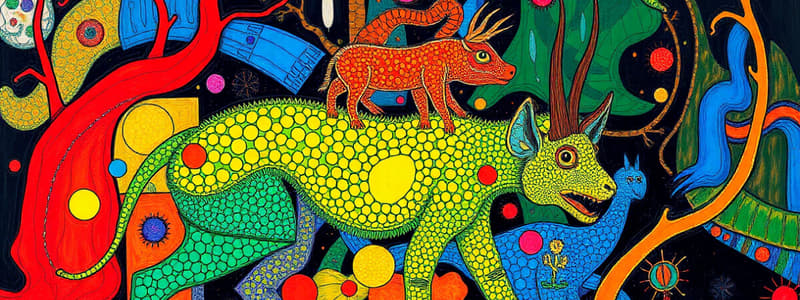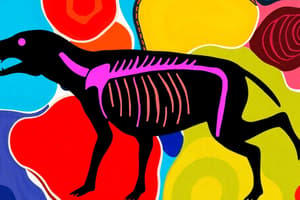Podcast
Questions and Answers
Which of the following correctly represents the hierarchy of organization in animals from simplest to most complex?
Which of the following correctly represents the hierarchy of organization in animals from simplest to most complex?
- Cell, Tissue, Organ, Organ System, Organism (correct)
- Organ System, Cell, Tissue, Organ, Organism
- Tissue, Cell, Organ, Organism, Organ System
- Organism, Organ System, Organ, Tissue, Cell
All specialized animal cells can survive independently.
All specialized animal cells can survive independently.
False (B)
What is the primary function of connective tissue?
What is the primary function of connective tissue?
Fills empty space and supports other tissues.
The ______ system is responsible for transporting blood and nutrients throughout the body.
The ______ system is responsible for transporting blood and nutrients throughout the body.
Match the tissue type with its description:
Match the tissue type with its description:
What type of stem cells are pluripotent and can differentiate into all types of cells in the body?
What type of stem cells are pluripotent and can differentiate into all types of cells in the body?
Tissue (Adult) Stem Cells can differentiate into any type of cell in the body.
Tissue (Adult) Stem Cells can differentiate into any type of cell in the body.
Define cellular differentiation.
Define cellular differentiation.
Stem cells derived from __________ can be used to treat childhood cancers like leukemia.
Stem cells derived from __________ can be used to treat childhood cancers like leukemia.
Which of the following tissues do not have the ability to repair or regenerate?
Which of the following tissues do not have the ability to repair or regenerate?
Match the following stem cell types with their characteristics:
Match the following stem cell types with their characteristics:
Regeneration or repair in complex animal cells can occur in all tissues equally.
Regeneration or repair in complex animal cells can occur in all tissues equally.
The specialized tissue that contains stem cells for blood cell production is __________.
The specialized tissue that contains stem cells for blood cell production is __________.
Flashcards
Tissue
Tissue
A group of similar cells that work together to perform a specific task.
Organ
Organ
A structure made up of two or more types of tissue that work together to perform a complex function.
Organ system
Organ system
A group of organs that work together to carry out a vital life function.
Hierarchy of organization
Hierarchy of organization
Signup and view all the flashcards
Multicellular organism
Multicellular organism
Signup and view all the flashcards
Cellular Differentiation
Cellular Differentiation
Signup and view all the flashcards
Stem Cell
Stem Cell
Signup and view all the flashcards
Embryonic Stem Cells
Embryonic Stem Cells
Signup and view all the flashcards
Tissue (Adult) Stem Cells
Tissue (Adult) Stem Cells
Signup and view all the flashcards
Regeneration
Regeneration
Signup and view all the flashcards
Study Notes
Hierarchy of Structure in Animals
- Animals are multicellular, meaning they are made of many specialized cells.
- Specialized animal cells cannot survive independently, requiring cooperative groups of cells to form tissues, organs, and organ systems.
- Large animals can comprise trillions of individual cells.
Multicellular Organisms
- Animals are composed of many different specialized cells.
- These specialized cells work together as part of a larger group, forming the organism's body.
- Complex organisms may include trillions of cells.
Complexity in Animals
- Animals display varying degrees of complexity. Visual examples (images) of animal complexity are shown.
Hierarchy of Animals
- Cells form a hierarchy, with increasing levels of complexity.
- An arrangement or classification of things by order of increasing complexity in animals.
- Functioning in organisms depends on the hierarchy of organization within the animal.
Hierarchy in Animals: Example
- Cell: A basic unit of life (e.g., heart muscle cell).
- Tissue: Groups of similar cells (e.g., heart muscle tissue).
- Organ: Structures composed of tissues (e.g., heart).
- Organ system: Multiple organs working together (e.g., circulatory system).
- Organism: A complete living thing (e.g., human).
Organ System
- Organ systems consist of one or more organs and structures operating together for essential life functions.
- Examples include the digestive, circulatory, and respiratory systems.
- Diagrams (illustrations) depict the respiratory and digestive systems.
Organ
- Organs are made of two or more tissue types working together for complex life processes.
- Specific organ examples are shown: heart, lungs, and stomach.
Tissue
- Tissues are collections of similar cells that perform specific, though limited, functions.
- Types of tissue include: epithelial, connective, muscle, and nerve tissue
- Examples of specific tissues are provided, such as lining of digestive system, tendons, smooth muscle, and nerves in sensory organs.
- Additional detail on epithelial tissue: (example provided).
- Additional detail on connective tissue: (example provided).
- Additional detail on muscle tissue (example provided).
- Additional detail on nerve tissue (example provided).
3.2 Stem Cells and Cell Differentiation
- Stem Cells: Undifferentiated cells capable of differentiating into various cell types.
- Stem cells give rise to all the specialized cell types in the body.
- A diagram illustrates the connection between stem cells and various differentiated cells (muscle, blood, nerve, cardiac).
Cellular Differentiation
- Differentiation is the process that creates specialized cells to carry out particular functions.
- Genetic material (DNA) directs differentiation and is passed on through generations.
- A diagram illustrates the process of differentiation, showing the expression of specific genes to generate distinct cell types.
Stem Cells: Types
- Embryonic Stem Cells: Pluripotent (able to differentiate into many cell types).
- Tissue (Adult) Stem Cells: Multipotent (capable of differentiating into limited cell types).
Stem Cells: Sources
- Embryonic stem cells: Derived from embryos. Can differentiate into many cell types.
- Tissue (adult) stem cells: Found in adult tissue. Can differentiate into a limited range of cell types.
- Examples include stem cells from bone marrow, umbilical cord.
Regeneration or Repair
- In complex animals, some tissues can regenerate or repair after damage (e.g., muscle, skin, bone).
- Other tissues cannot regenerate (e.g., nerve tissue).
- A diagram (illustration) shows the regeneration of a starfish arm.
How Cells Become Specialized
- This section provides a visual representation of how cells become specialized.
Homework
- Specific pages and questions in a textbook are assigned for homework.
Answers
- Solutions to assigned textbook questions regarding organ systems and cells are provided.
- Detailed explanations of those solutions are included (cell differentiation and regeneration).
Studying That Suits You
Use AI to generate personalized quizzes and flashcards to suit your learning preferences.




